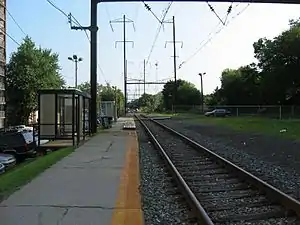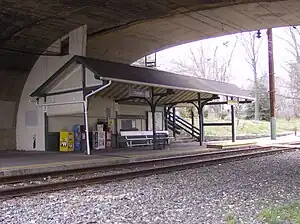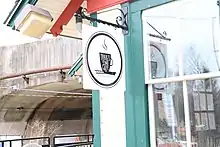| Cynwyd Line | ||||||||||||||||||||||||||||||||||||||||||||||||||||||||||||||||||||||||||||||||||||||||||||||||||||||||||||||||||||||||||||||||||||||||||||||||||||||||||||||||||
|---|---|---|---|---|---|---|---|---|---|---|---|---|---|---|---|---|---|---|---|---|---|---|---|---|---|---|---|---|---|---|---|---|---|---|---|---|---|---|---|---|---|---|---|---|---|---|---|---|---|---|---|---|---|---|---|---|---|---|---|---|---|---|---|---|---|---|---|---|---|---|---|---|---|---|---|---|---|---|---|---|---|---|---|---|---|---|---|---|---|---|---|---|---|---|---|---|---|---|---|---|---|---|---|---|---|---|---|---|---|---|---|---|---|---|---|---|---|---|---|---|---|---|---|---|---|---|---|---|---|---|---|---|---|---|---|---|---|---|---|---|---|---|---|---|---|---|---|---|---|---|---|---|---|---|---|---|---|---|---|---|---|---|
 The Cynwyd Line at Wynnefield Avenue in July 2005 | ||||||||||||||||||||||||||||||||||||||||||||||||||||||||||||||||||||||||||||||||||||||||||||||||||||||||||||||||||||||||||||||||||||||||||||||||||||||||||||||||||
| Overview | ||||||||||||||||||||||||||||||||||||||||||||||||||||||||||||||||||||||||||||||||||||||||||||||||||||||||||||||||||||||||||||||||||||||||||||||||||||||||||||||||||
| Status | Operating | |||||||||||||||||||||||||||||||||||||||||||||||||||||||||||||||||||||||||||||||||||||||||||||||||||||||||||||||||||||||||||||||||||||||||||||||||||||||||||||||||
| Owner | SEPTA | |||||||||||||||||||||||||||||||||||||||||||||||||||||||||||||||||||||||||||||||||||||||||||||||||||||||||||||||||||||||||||||||||||||||||||||||||||||||||||||||||
| Termini | ||||||||||||||||||||||||||||||||||||||||||||||||||||||||||||||||||||||||||||||||||||||||||||||||||||||||||||||||||||||||||||||||||||||||||||||||||||||||||||||||||
| Stations | 3 | |||||||||||||||||||||||||||||||||||||||||||||||||||||||||||||||||||||||||||||||||||||||||||||||||||||||||||||||||||||||||||||||||||||||||||||||||||||||||||||||||
| Website | septa.org | |||||||||||||||||||||||||||||||||||||||||||||||||||||||||||||||||||||||||||||||||||||||||||||||||||||||||||||||||||||||||||||||||||||||||||||||||||||||||||||||||
| Service | ||||||||||||||||||||||||||||||||||||||||||||||||||||||||||||||||||||||||||||||||||||||||||||||||||||||||||||||||||||||||||||||||||||||||||||||||||||||||||||||||||
| Type | Commuter rail | |||||||||||||||||||||||||||||||||||||||||||||||||||||||||||||||||||||||||||||||||||||||||||||||||||||||||||||||||||||||||||||||||||||||||||||||||||||||||||||||||
| System | SEPTA Regional Rail | |||||||||||||||||||||||||||||||||||||||||||||||||||||||||||||||||||||||||||||||||||||||||||||||||||||||||||||||||||||||||||||||||||||||||||||||||||||||||||||||||
| Services | 1 | |||||||||||||||||||||||||||||||||||||||||||||||||||||||||||||||||||||||||||||||||||||||||||||||||||||||||||||||||||||||||||||||||||||||||||||||||||||||||||||||||
| Operator(s) | SEPTA Regional Rail | |||||||||||||||||||||||||||||||||||||||||||||||||||||||||||||||||||||||||||||||||||||||||||||||||||||||||||||||||||||||||||||||||||||||||||||||||||||||||||||||||
| Rolling stock | Electric Multiple Units | |||||||||||||||||||||||||||||||||||||||||||||||||||||||||||||||||||||||||||||||||||||||||||||||||||||||||||||||||||||||||||||||||||||||||||||||||||||||||||||||||
| Daily ridership | 505 (FY 2019)[1] | |||||||||||||||||||||||||||||||||||||||||||||||||||||||||||||||||||||||||||||||||||||||||||||||||||||||||||||||||||||||||||||||||||||||||||||||||||||||||||||||||
| Technical | ||||||||||||||||||||||||||||||||||||||||||||||||||||||||||||||||||||||||||||||||||||||||||||||||||||||||||||||||||||||||||||||||||||||||||||||||||||||||||||||||||
| Track gauge | 4 ft 8+1⁄2 in (1,435 mm) standard gauge | |||||||||||||||||||||||||||||||||||||||||||||||||||||||||||||||||||||||||||||||||||||||||||||||||||||||||||||||||||||||||||||||||||||||||||||||||||||||||||||||||
| Electrification | Overhead line, 12 kV 25 Hz AC | |||||||||||||||||||||||||||||||||||||||||||||||||||||||||||||||||||||||||||||||||||||||||||||||||||||||||||||||||||||||||||||||||||||||||||||||||||||||||||||||||
| ||||||||||||||||||||||||||||||||||||||||||||||||||||||||||||||||||||||||||||||||||||||||||||||||||||||||||||||||||||||||||||||||||||||||||||||||||||||||||||||||||

The Cynwyd Line is a SEPTA Regional Rail line from Center City Philadelphia to Cynwyd in Montgomery County, Pennsylvania. Originally known as the Ivy Ridge Line, service was truncated on May 17, 1986,[2] at its current terminus at Cynwyd.
Track between Cynwyd and Ivy Ridge was dismantled between 2008 and 2010 for conversion as an interim rail trail, preventing service restoration for the foreseeable future. The Cynwyd Line is the shortest of the SEPTA regional rail lines, and is the second-shortest regional rail line in the United States after New Jersey Transit's Princeton Branch. It is by far the least ridden SEPTA Regional Rail Line. It is fully grade-separated.
Route
The Cynwyd Line runs from Suburban Station to the 52nd Street Junction, where it diverges from Amtrak's Philadelphia-to-Harrisburg line. It makes station stops at Wynnefield Avenue, Bala, and Cynwyd before stopping just short of the Schuylkill River.
History
The Cynwyd Line is the truncated remnant of the Pennsylvania Railroad's Schuylkill Branch, which ran from Philadelphia to Pottsville, Pennsylvania.[3] Electrified service was opened between Philadelphia and Norristown (Haws Avenue) on June 20, 1930. Plans for electrification beyond Norristown, to Phoenixville, were not carried out. Passenger service ended between Manayunk and Norristown on October 29, 1960 and the line beyond Manayunk was de-electrified, although the pylons remain.
In 1980 SEPTA extended service from Manayunk to a new park-and-ride station at Ivy Ridge.[4]
Service beyond Cynwyd was suspended on May 27, 1986, because of poor track conditions[5] and concerns about the Manayunk Bridge over the Schuylkill River.[6]
Between 1984–2010, the route was designated R6 Ivy Ridge (later R6 Cynwyd) as part of SEPTA's diametrical reorganization of its lines. Ivy Ridge Line trains operated through the city center to the Manayunk/Norristown Line on the ex-Reading side of the system.[7] The R-number naming system was dropped on July 25, 2010.[8]
In the late 1990s and up to 2003, SEPTA funded a study called the Schuylkill Valley Metro which included plans to extend both sides of the R6 line to Pottstown, Reading and Wyomissing, Pennsylvania. The project suffered a major setback when it was rejected by the FTA New Starts program, which cited doubts about the ridership projections and financing assumptions used by the study.[9]
Though there have been repeated calls to restore the "temporarily" discontinued service between Cynwyd and Ivy Ridge, SEPTA permanently dropped plans for restoration in 2008 when all trackage north of Cynwyd to Ivy Ridge was removed between 2008 and June 2010 to make way for the Cynwyd Heritage Trail[10] and Ivy Ridge Trail.[11]
On October 29, 2010, the Cynwyd Line was where the Silverliner V rail cars made their first run in revenue service,[12] and, on June 29, 2012, where the final Silverliner IIs and IIIs ran in revenue service before being fully retired.[13]
SEPTA activated positive train control on the Cynwyd Line on November 21, 2016.[14]
On April 9, 2020, the line was suspended indefinitely due to a staff shortage caused by the COVID-19 pandemic.[15] Limited service resumed on September 7, 2021.[16]
Following the Interstate 95 bridge collapse on June 11, 2023, SEPTA used vehicles and human resources from Cynwyd Line to operate additional services on Trenton Line, West Trenton Line, and Fox Chase Line starting June 12. Rail services on Cynwyd Line were replaced by buses running to Overbrook station and connecting to Paoli/Thorndale Line trains.[17][18] Train service on the Cynwyd Line resumed on June 26, 2023.[19]
Stations

The Cynwyd Line includes the following stations north of 30th Street Station; stations indicated with gray background are closed.[20]
| Zone | Location | Station | Miles (km) from Center City |
Connections / notes |
|---|---|---|---|---|
| C | Parkside, Philadelphia | 52nd Street | 4.0 (6.4) | Closed August 23, 1980[5] |
| 1 | Wynnefield, Philadelphia | Wynnefield Avenue |
4.9 (7.9) | |
| 2 | Bala Cynwyd | Bala |
5.7 (9.2) | |
| Cynwyd |
6.1 (9.8) | |||
| Barmouth | 6.8 (10.9) | Closed May 27, 1986[5] | ||
| Manayunk, Philadelphia | Manayunk West | 7.8 (12.6) | Closed May 27, 1986[5] | |
| Roxborough, Philadelphia | Ivy Ridge | 8.5 (13.7) | Closed May 27, 1986[5] | |
Ridership
From fiscal 2008 to fiscal 2019, yearly ridership on the Cynwyd Line has ranged from 130,000 to 180,000, peaking at 184,138 in fiscal 2014. Ridership dipped to 122,510 in fiscal 2017 but recovered the following year.[note 1]

Notes
References
- 1 2 "Fiscal Year 2021 Service Plan Update". SEPTA. June 2020. p. 24. Retrieved March 11, 2022.
- ↑ "Ivy Ridge line closed, May 18, 1986 - Newspapers.com". Archived from the original on 2020-07-05.
- ↑ "Eastern Region, Philadelphia Terminal Division, Schuylkill Branch Map Showing Switching Districts As Shown On General Notice No. 503 2-14-1950" (PDF). 1950. Retrieved August 14, 2016.
- ↑ Williams, Gerry (1998). Trains, Trolleys & Transit: A Guide to Philadelphia Area Rail Transit. Piscataway, New Jersey: Railpace Company. pp. 84–86. ISBN 978-0-9621541-7-1.
- 1 2 3 4 5 Baer, Christopher T. (April 2015). "A GENERAL CHRONOLOGY OF THE SUCCESSORS OF THE PENNSYLVANIA RAILROAD COMPANY AND THEIR HISTORICAL CONTEXT: 1980-1989" (PDF). Pennsylvania Railroad Technical and Historical Society. Retrieved October 29, 2017.
- ↑ "Starting the Second Life of a Manayunk Icon". 16 July 2014.
- ↑ Vuchic, Vukan; Kikuchi, Shinya (1984). General Operations Plan for the SEPTA Regional High Speed System. Philadelphia: SEPTA. pp. 2–8.
- ↑ Lustig, David (November 2010). "SEPTA makeover". Trains Magazine. Kalmbach Publishing: 26.
- ↑ "fta.dot.gov". Archived from the original on 2010-05-28. Retrieved 2010-07-29.
- ↑ cynwydtrail.org/
- ↑ "Ivy Ridge Green". Archived from the original on 2011-07-26. Retrieved 2010-10-21.
- ↑ Geringer, Dan (October 30, 2010). "Mass appeal for SEPTA's new Silverliner V train". Philadelphia Daily News. Retrieved November 1, 2010.
- ↑ "SEPTA to scrap the last 'Silverliner II'". 29 June 2012.
- ↑ "Positive Train Control Update". SEPTA. May 1, 2017. Retrieved May 17, 2017.
- ↑ "Service Information". SEPTA. Retrieved April 14, 2020.
- ↑ "Regional Rail Select Schedule Changes". SEPTA. Retrieved August 19, 2021.
- ↑ "I-95 Philadelphia collapse: SEPTA adds, modifies lines and service to ease commuting troubles". Fox 29 Philadelphia. 2023-06-11.
- ↑ "Until Further Notice: SEPTA Is Adding Extra Capacity And Service Due To I-95 Bridge Collapse". SEPTA. 6 June 2023. Retrieved June 11, 2023.
- ↑ "Beginning Monday, June 26: SEPTA Is Adjusting Capacity And Service Due To I-95 Reopening". SEPTA. 6 June 2023. Retrieved June 23, 2023.
- ↑ "Cynwyd Line Timetable" (PDF). Philadelphia, Pennsylvania: Southeastern Pennsylvania Transportation Authority. September 10, 2017. Retrieved October 29, 2017.
- ↑ "Fiscal Year 2020 Annual Service Plan" (PDF). SEPTA. June 2019. p. 42. Archived from the original (PDF) on August 27, 2020. Retrieved December 14, 2019.
- ↑ "Fiscal Year 2019 Annual Service Plan" (PDF). SEPTA. June 2018. p. 74. Archived from the original (PDF) on February 19, 2021. Retrieved December 14, 2019.
- ↑ "Fiscal Year 2018 Annual Service Plan" (PDF). SEPTA. June 2017. p. 44. Archived from the original (PDF) on February 19, 2021. Retrieved December 14, 2019.
- ↑ "Fiscal Year 2017 Annual Service Plan" (PDF). SEPTA. October 2016. p. 70. Archived from the original (PDF) on February 19, 2021. Retrieved December 14, 2019.
- ↑ "Fiscal Year 2016 Annual Service Plan" (PDF). SEPTA. June 2015. p. 94. Archived from the original (PDF) on February 19, 2021. Retrieved December 14, 2019.
- ↑ "Fiscal Year 2015 Annual Service Plan" (PDF). SEPTA. May 2014. p. 60. Archived from the original (PDF) on October 6, 2014. Retrieved December 14, 2019.
- ↑ "Fiscal Year 2014 Annual Service Plan" (PDF). SEPTA. May 2013. p. 44. Archived from the original (PDF) on February 19, 2021. Retrieved December 14, 2019.
- ↑ "Fiscal Year 2013 Annual Service Plan" (PDF). SEPTA. May 2012. p. 55. Archived from the original (PDF) on February 19, 2021. Retrieved December 14, 2019.
- ↑ "Fiscal Year 2012 Annual Service Plan" (PDF). SEPTA. July 2011. p. 94. Archived from the original (PDF) on February 19, 2021. Retrieved December 14, 2019.
- ↑ "Fiscal Year 2011 Annual Service Plan" (PDF). SEPTA. June 2010. p. 70. Archived from the original (PDF) on February 19, 2021. Retrieved December 14, 2019.
- ↑ "Fiscal Year 2010 Annual Service Plan" (PDF). SEPTA. June 2009. p. 63. Archived from the original (PDF) on February 19, 2021. Retrieved December 14, 2019.